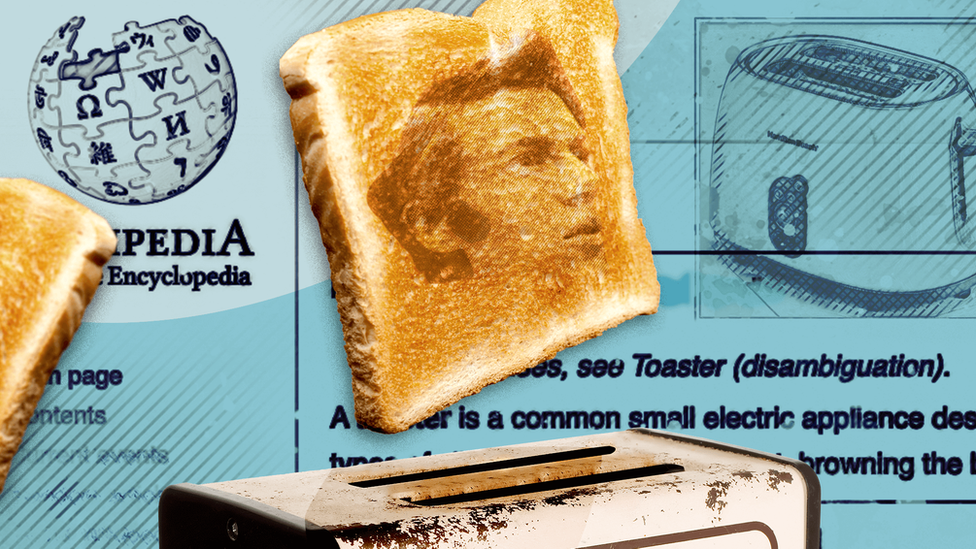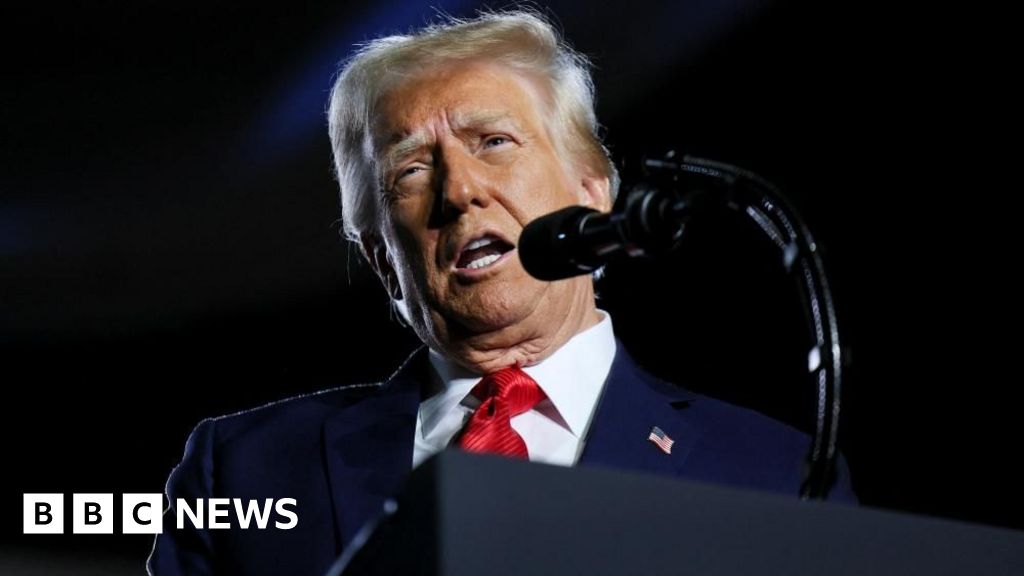ARTICLE AD BOX

By Marco Silva
BBC Trending
For more than a decade, a prankster spun a web of deception about the inventor of the electric toaster. His lies fooled newspapers, teachers and officials. Then a teenager flagged up something that everyone else had missed.
"I read through Wikipedia a lot when I'm bored in class," says Adam, aged 15, who studies photography and ICT at a school in Kent.
One day last July, one of his teachers mentioned the online encyclopedia's entry about Alan MacMasters, who it said was a Scottish scientist from the late 1800s and had invented "the first electric bread toaster".
At the top of the page was a picture of a man with a pronounced quiff and long sideburns, gazing contemplatively into the distance - apparently a relic of the 19th Century, the photograph appeared to have been torn at the bottom.
But Adam was suspicious. "It didn't look like a normal photo," he tells me. "It looked like it was edited."
This "Alan MacMasters" Wikipedia article stayed online for more than nine years
After he went home, he decided to post about his suspicions on a forum devoted to Wikipedia vandalism.
Little did he know that he had just set in motion a chain of events that would lead me to "Alan MacMasters" - not the inventor of the electric toaster, but his real-life alter ego.
The inventor of the toaster who never was
Until recently, if you had searched for "Alan MacMasters" on Wikipedia, you would have found the same article that Adam did.
And who would have doubted it?
After all, like most Wikipedia articles, this one was peppered with references: news articles, books and websites that supposedly provided evidence of MacMasters' life and legacy.
As a result, lots of people accepted that MacMasters had been real.
More than a dozen books, published in various languages, named him as the inventor of the toaster. And, until recently, even the Scottish Government's Brand Scotland website listed the electric toaster as an example of the nation's "innovative and inventive spirit".
In his supposed home country, MacMasters had become a folk hero of sorts.
One Scottish primary school organised a day of activities in his memory - children were invited to write journal entries about MacMasters, paint slices of toast, and build pretend toasters out of building blocks.
Edinburgh-based chef Scott Smith also created an elaborate dessert in his honour, while taking part in Great British Menu, the BBC cookery show. Smith says MacMasters' name was suggested to him by the producers, but they never responded to our requests for comment.
In 2018, when the Bank of England asked the British public who should appear on the next £50 note, MacMasters was nominated - and included on a list along with 988 other apparently eligible contenders who had made significant contributions to science.
The Bank of England did not want to comment on this story, but confirmed MacMasters had been dropped from the longlist after extra checks were made.
All the while, as the world got to know the supposed Scottish inventor, there was someone in London who could not avoid a smirk as the name "Alan MacMasters" popped up - again and again - on his screen.
Image source, Alan MacMasters
Image caption,Aerospace engineer Alan MacMasters
Alan MacMasters, 30, is an aerospace engineer from London "and not the inventor of the toaster", he assures me with a giggle. "You shouldn't just believe everything you read on the internet."
I feel nervous about the possibility of falling prey to another prank. So I ask Alan to send me a photo of his passport, which he does.
He is not lying: even if he lacks the voluminous quiff of his namesake, he really is Alan MacMasters ("half Japanese and half Scottish", he adds by text).
"One day, my father said to me: 'Maybe we are related to the inventor of the toaster?' And I had to disappoint him," he recalls.
And that was because Alan knew the truth: he was there when the toaster hoax began more than a decade ago.
The Alan MacMasters' legend is born
On 6 February 2012, Alan was at a university lecture, when the class was warned against using Wikipedia as a source.
To hammer the point home, the lecturer said that a friend of his - one "Maddy Kennedy" - had named himself on the site as the inventor of the toaster.
Alan and his classmates found the story "amusing" but pondered correcting the article - after all, one of Wikipedia's distinguishing features is that pretty much anyone can edit it.
Sitting right next to Alan was one of his closest friends, Alex, who volunteered to do the editing himself.
Alex recalls: "I just changed it so that it said that my friend, who sat next to me, Alan MacMasters, had in fact invented the toaster in Edinburgh in 1893.
"We had no idea who invented the toaster."
Internet history had just been made, but Alan was not bothered.
"Alex is a bit of a joker, it's part of why we love him," he says. "The article had already been vandalised anyway, it was just changing the nature of the incorrect information.
"I thought it was funny, I never expected it to last."
Wikipedia relies on volunteers to ensure articles are as accurate as they can be.
This involves checking articles are properly sourced, clearly written, and that - in general - they have not been vandalised or tampered with.
But it is a huge job. On English Wikipedia alone, there are more than 6.5m articles and fewer than 125,000 regular editors.
It is almost inevitable that some articles will fall through the cracks - and the article exploring the origins of the toaster was one of them.
"At the time, we had a good laugh about the change, but we quickly forgot about it," says Alex, the hoaxer.
But the internet does not forget.
From that day onwards, anyone who looked up the inventor of the toaster on Wikipedia would have found "Alan MacMasters" as the answer.
And it was not long before the Daily Mirror wrongly listed MacMasters' toaster as a "life-changing everyday invention that put British genius on the map". Reach, which owns the Mirror, declined to comment.
Alex felt mischievous, and wondered how far his prank could go.
He asked himself what would happen if he created a Wikipedia article entirely devoted to the supposed inventor of the toaster.
More importantly, he wondered how long it would be before the platform's volunteer editors exposed his forgery.
In February 2013, Alan MacMasters' very own Wikipedia article was born.
The supposed photograph of "Alan MacMasters" made schoolboy Adam suspicious
To illustrate it, Alex grabbed a photo of himself and edited it to look like an image from the 1800s - this was the very same photo that, years later, would catch Adam's eye.
At the time, Alex felt this was a harmless prank.
"If you get false information about who invented the toaster, the consequences might be that you get a question wrong in a pub quiz," he says. "It's a bit of trivia, which doesn't have a significant real-world impact."
But was that really the case?
Soon, the name "Alan MacMasters" would spread rapidly around the world as the inventor of the toaster.
Over more than a decade, his life story was retold by major news outlets, official bodies and even a US museum.
The more people became aware of MacMasters, the more complex Alex's deception became.
"The article started out as just a couple of sentences and, over time, I decided to start writing more and more ridiculous things," he says.
Among other details, he falsely suggested MacMasters had helped develop lighting systems for the London Underground.
"These [claims] would get picked up in different types of media, I would cite them, and they would become fact," Alex says.
Image source, Andre Morawski
Image caption,Heather Ford says the hoax highlights Wikipedia's role in "determining what gets recognised as true"
This may well be part of the reason why the MacMasters hoax survived for so long.
"What you have here is circular referencing," says Heather Ford, an associate professor at the University of Technology Sydney.
When journalists repeat a claim that is made online, their reporting can then be used on Wikipedia as evidence to back the original claim.
"Wikipedia is just collecting all of these sources and citations, as it continues to build this article that originally was built on this lie," Ford says.
MacMasters walks into the sunset
For years, no one appears to have raised any suspicions online - at least, until 15-year-old Adam posted his concerns on a Reddit forum.
His thread was titled: "The picture of the inventor of the toaster on Wikipedia was faked."
At this stage, Adam was unaware that Scottish inventor Alan MacMasters was not real - only that the photo used to illustrate his Wikipedia article appeared to be fake.
"A lot of people actually replied: 'I have used that picture in a presentation for school,'" Adam recalls. "I thought it was hilarious."
But after his post went live, it was rapidly shared on Wikipediocracy, a forum known for scrutinising the online encyclopedia.
This in turn alerted Wikipedia editors who, in less than 24 hours, had nominated the article for deletion.
Within a week, a "hoax" label had been added at the top of the article. And, in September, the article was changed so that anyone looking for MacMasters on Wikipedia was redirected to a page about hoaxes instead.
Alex's Wikipedia account, which he used to create the MacMasters article, has been blocked.
The Wikimedia Foundation, which runs Wikipedia, tells the BBC it takes hoaxes and misinformation "very seriously".
It accepts hoaxes take place "from time to time", but says the site is protected "through a combination of machine learning tools and human oversight from volunteer editors".
It also says misinformation and hoaxes are "generally addressed by volunteers via existing rules and processes", and that they are "outside of the Wikimedia Foundation's remit".
In a statement, it says: "In general, the Foundation only gets involved in content related issues on the platform in case of specific cases of disinformation or legal matters."
Who did invent the toaster, then?
Getting to the bottom of this mystery was not easy. I spoke to toaster collectors in Europe and in the US, as well as museum curators with expertise in domestic appliances.
According to multiple sources, the first patent for a commercially available and successful toaster was submitted by Frank Shailor in 1909, on behalf of the General Electric company in the US.
The toaster, named the D-12, is understood to be the first commercially available electric toaster.
Image source, Ingenium
Image caption,The D-12 toaster, created by Frank Shailor in 1909 for General Electric
"It is beautiful," says Rebecca Dolgoy, curator of natural resources and industrial technologies at Ingenium, Canada's museums of science and innovation (which hold two D-12 toasters).
"You would put the bread inside, it would toast one side at a time, and you would have to switch it. The machine is very elegant, but also utilitarian."
As I speak to her, I notice the passion in Ms Dolgoy's words. "I'm interested in the toasters because they are fascinating, but also because of the kinds of stories that they allow us to tell," she tells me.
And the story of Alan MacMasters, the inventor, is certainly one of them. It just happens not to be true.

 2 years ago
62
2 years ago
62








 English (US) ·
English (US) ·